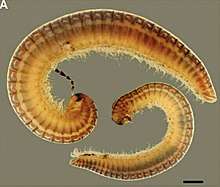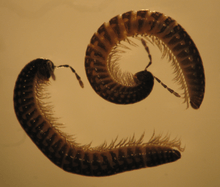Stemmiulidae
Stemmiulida is an order of millipedes consisting of approximately 130 species, reaching up to 50 mm in length. It contains a single family, Stemmiulidae.
| Stemmiulidae | |
|---|---|
 | |
| Stemmiulus beroni, a West African species | |
| Scientific classification | |
| Kingdom: | |
| Phylum: | |
| Subphylum: | |
| Class: | |
| Subclass: | |
| Infraclass: | |
| Superorder: | Nematophora |
| Order: | Stemmiulida Cook, 1895 |
| Family: | Stemmiulidae Pocock, 1894 |

Description
Stemmiulids are small to medium sized millipedes, reaching a maximum length of 50 mm (2 in). The body tapers gradually, and is laterally compressed, so is taller than wide. A dorsal groove is present and runs from head to tail. The eyes consist of two large ocelli on each side of the head, and some members are capable of jumping.[1][2] The living species lack Tömösváry organs, although a fossil species from the Miocene epoch possesses them.[3]
Classification
Stemmiluda contains 6-10 living genera and at least one fossil genus, all in the family Stemmiulidae. Species estimates range from about 120 to 150 species.[4][5] The taxonomy is controversial, with some authors lumping species into as few as three genera.[5] The most liberal classification is presented below.[6]
- Diopsiulus
- Eostemmiulus[7]
- Nethoiulus
- Paurochaeturus
- †Parastemmiulus (Early-Middle Miocene; Mexican amber)[3]
- Plusiochaeturus
- Prostemmiulus
- Scoliogmus
- Stemmatoiulus
- Stemmijulus
- Stemmiulus
References
| Wikimedia Commons has media related to Stemmiulidae. |
- "Diagnostic features of Millipede Orders" (PDF). Milli-PEET Identification Tables. The Field Museum, Chicago. Retrieved 5 April 2014.
- "Putative apomorphies of millipede clades" (PDF). Milli-PEET: Millipede Systematics. The Field Museum, Chicago, IL. 26 September 2006.
- Riquelme, F.; Alvarado-Ortega, J.; Ramos-Arias, M.; Hernández, M.; Dez, I.; Lee-Whiting, T. A.; Ruvalcaba-Sil, J. L. (2013). "A fossil stemmiulid millipede (Diplopoda: Stemmiulida) from the Miocene amber of Simojovel, Chiapas, México". Historical Biology: 1–13. doi:10.1080/08912963.2013.778843.
- Sierwald, Petra; Bond, Jason E. (2007). "Current Status of the Myriapod Class Diplopoda (Millipedes): Taxonomic Diversity and Phylogeny". Annual Review of Entomology. 52 (1): 401–420. doi:10.1146/annurev.ento.52.111805.090210. PMID 17163800.
- Shear, W. (2011). "Class Diplopoda de Blainville in Gervais, 1844. In: Zhang, Z.-Q. (Ed.) Animal biodiversity: An outline of higher-level classification and survey of taxonomic richness" (PDF). Zootaxa. 3148: 159–164.
- Sierwald, Petra (ed.) (2006). "Nomenclator Generum Diplopodorum, Version 2. A complete listing of all genus-group names in the class Diplopoda from 1758 through 1999". Field Museum of Natural History. Retrieved 4 April 2014.CS1 maint: extra text: authors list (link)
- Mauriès, J. P., Golovatch, S. I., & Geoffroy, J. J. (2010). "Un nouveau genre et une nouvelle espèce de l ordre Stemmiulida du Viet-Nam (Diplopoda) [A new genus and species of the order Stemmiulida from Vietnam]". Arthropoda Selecta. 19 (2): 73–80.CS1 maint: uses authors parameter (link)